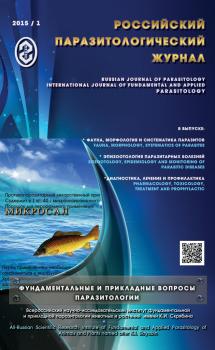Objective of research: The target of the paper is to develop a model of GIS-based risk monitoring of zoonotic cestodiasis in human. Materials and methods: The use of geographic information systems (GIS) as an epizootiological and epidemiological method for the risk-based monitoring of human cestodiasis enables the development of a multi-level platform for solution of a wide range of tasks related to the control of this disease. The modern GIS tools use the methods of geoinformatics applying powerful software and hardware: open access geographic web servers, tools for multidimensional complex analysis, creating most accurate electronic and paper maps. Full-featured GIS contain a full set for processing geospatial data including acquisition of data, its integration and storage, automatic data processing, editing, creation and maintenance of topology, spatial analysis, access to the database management system (DBMS), visualization and creation of hard copies of any cartographic data. Results and discussion: The use of GIS enables to study more closely the regularities of epizootic process, geography of human cestodiasis and to improve the methodology both for short-term and long-term retrospective epizootiological analyses.
geographic information systems (GIS), risk-based monitoring, the OIE List, hydatid disease, hydatidosis, cysticercosis, taeniasis, beef tapeworm infection.
Введение
По данным Всемирной Организации Здравоохранения (ВОЗ) человечеству угрожает более 500 видов паразитарных червей. В мире зарегистрировано свыше 150 болезней, передающихся от животных к человеку. Эти заболевания ежегодно уносят более 15 миллионов человеческих жизней.Антропозоогельминтозы (гельминтозоонозы) — гельминтозы, возбудители которых способны паразитировать у человека и животных (греч. anthropos — человек, zoоn — животное, nosus — болезнь). Среди этих паразитов большое значение для ветеринарии и медицины имеют цестоды, которые на разных стадиях жизненного цикла поражают и животных, и человека. Об актуальности данных заболеваний свидетельствует тот факт, что эхинококкоз и цистицеркоз свиней включены в Список МЭБ (OIE Listed diseases), в который в настоящее время входят 119 наиболее опасных и экономически значимых болезней животных [1, 13, 14, 15].
При одних цестодозах половозрелая стадия возбудителя обитает в кишечнике у человека (тенииды), а личиночная — у животных (цистицерки). При других (эхинококкоз) у человека и животных локализуются личиночные стадии паразитических червей, а у плотоядных — половозрелые гельминты.
Целью исследований являлась разработка модели риск-ориентированного мониторинга антропозоонозных цестодозов на основе геоинформационных систем (ГИС).
1. Bessonov A.S. Tsistnyi ehinokokkoz i gidatidoz [Cystic echinococcosis and hydatidosis]. M., VIGIS, 2007. 672 p.
2. Georgiu H., Belimenko V.V., Samoylovskaya N.A. Parazitarnye bolezni zhivotnyh iz Spiska MEB [OIE-listed parasitic diseases of animals]. M., Infra-M, 2016. 88p.
3. Gorokhov V.V., Samoylovskaa N.A., Skira V.N. Forecast of epizootic situation on main helminthiases in the Russian Federation for the year 2013. Rossiyskiy parazitologichesky zhurnal [Russian Journal of Parasitology], 2013, no. 4, pp. 57 -59.
4. Gorokhov V.V., Samoylovskaya N.A., Peshkov R.A. Forecast of epizootic situation on main helminthiases of animals in the Russian Federation for the year 2014. Rossiyskiy parazitologichesky zhurnal [Russian Journal of Parasitology], 2014, no. 2, pp. 32-33.
5. Gorokhov V.V, Samoylovskaya N.A., Uspenskiy A.V., Klyonova I.F., Peshkov R.A., Puzanova E.V., Moskvin A.S. Current epizootic situation and forecast on main helminthiases of animals in the Russian Federation for the year 2015. Rossiyskiy parazitologichesky zhurnal [Russian Journal of Parasitology], 2015, no.1, pp. 41-45.
6. Kapustin V.F. Atlas gel’mintov sel’skohozjajstvennyh zhivotnyh [Atlas of the most common helminthes of the agricultural animals]. M., State Publishing House of Agricultural Literature, 1953. 139 p.
7. Samoylovskaya N.A. Infestation of elks with parasites in Losiny Ostrov National Park. Rossiyskiy parazitologichesky zhurnal [Russian Journal of Parasitology], 2008, no. 3, pp. 29-32.
8. Samoylovskaya N.A. Comparative analysis of parasite fauna in dappled deer from Losiny Ostrov National Park. Rossiyskiy parazitologichesky zhurnal [Russian Journal of Parasitology], 2008, no. 4, pp.13-16.
9. Samoylovskaya N.A. Ecology of helminths in wild ruminant from Losiny Ostrov National Park. Rossiyskiy parazitologichesky zhurnal [Russian Journal of Parasitology], 2013, no. 3, pp.45-49.
10. Razikov Sh.Sh. Epizootological process of echinococcosis in farm animals. Veterinarnaya patologiya [Veterinary pathology], 2009, no. 3, pp.123-125.
11. Khristianovskiy P.I., Belimenko V.V. Monitoring of echinoccocosis in farm animals from the Southern Ural. Rossiyskiy parazitologichesky zhurnal [Russian Journal of Parasitology], 2015, no. 2, pp. 26-27.
12. Shabeykin A.A., Gulyukin A.M., Hismatullina N.A. Experience in GIS technologies for estimating risk of epizootological monitoring. Sbornik trudov V Mezhdunarodnogo veterinarnogo kongressa [Proc. of the 5th Int. Vet. Congress. 22-24 Apr. 2015]. M., pp. 250-252.
13. Uspenskiy A.V., Gorokhov V.V. Parazitarnye zoonozy [Parasitic zoonoses]. M., 2012, 336p.
14. Eckert J., Gemmel М.А., Meslin F.-X, Pawlowski Z.S. WHO/OIE Manual on Echinococcosis in humans and animals; a public health problem of global concern. France. OIE, 2001. 265 p.
15. Terrestrial Animal Health Code. France. OIE, 2013.





